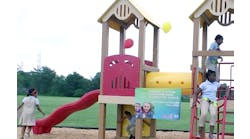Most schools provide playgrounds for students to unwind at recess or after school. But many playgrounds, because of poor design, faulty equipment or deteriorating materials, can pose safety risks.
About 156,000 people a year sustain injuries on public playgrounds that require emergency-room treatment, according to the U.S. Consumer Product Safety Commission. To coincide with National Playground Safety Week this year, the CPSC has released an updated Handbook for Public Playground Safety.
Among the key recommendations in the 40-page guide: Always supervise children on play equipment to make sure they are safe; purchase playground equipment that meets the latest safety standards; maintain at least 9 inches of protective surfacing (shredded/recycled rubber, wood chips, wood mulch, sand or pea gravel) under and around playground equipment to cushion children from falls; check that protective surfacing extends at least 6 feet in all directions from play equipment; for swings, extend protective surfacing in front and back of the swing, twice the height of the suspending bar.
Ropes, jump ropes, clotheslines, pet leashes or cords of any kind should never be attached to play equipment because of the risks of strangulation. Schools also can avoid injuries by repairing sharp points or edges on equipment, replacing missing hardware and closing “S” hooks.
The updated guide, noting that five or more sunburns double the risk of developing skin cancer, adds suggestions to help playground designers deal with children's exposure to the sun.
“Utilizing existing shade (e.g., trees), designing play structures as a means for providing shading (elevated platforms with shaded space below), or creating more shade (e.g., manmade structures) are potential ways to design a playground to help protect children's skin from the sun,” the guide says.
Bare metal slides and platforms should be situated in the shade or out of direct sunlight, the guide recommends. If trees are used to shade equipment, schools should be vigilant about keeping limbs trimmed and cleaning up debris.
The CPSC lists three categories for playground equipment: toddler (less than 2 years old); preschool (ages 2 to 5) and grade school (ages 5 to 12).
“For playgrounds intended to serve children of all ages, the layout of pathways and the landscaping of the playground should show the distinct areas for the different age groups,” the guide states. “The areas should be separated at least by a buffer zone, which could be an area with shrubs or benches. This … will reduce the chance of injury from older, more active children running through areas filled with younger children.”
The play area also should divide active, physical play from more passive and quiet recreation. For instance, moving equipment, such as swings and merry-go-rounds, should be toward a corner, side or edge of a play area; slide exits should be situated in an uncongested area.
The entire guide is online at http://www.cpsc.gov/CPSCPUB/PUBS/325.pdf.
NOTABLE
156,000
Estimated number of persons treated each year in hospital emergency rooms for injuries at public playgrounds.
9
In inches, the minimum depth of loose-fill materials for playground equipment up to 8 feet high.
6
In feet, the minimum distance that protective surface should extend (in all directions) from playground equipment.
16
In inches, the recommended maximum height for a playground balance beam for school-age children (ages 5 to 12).
Source: U.S. Consumer Product Safety Commission

